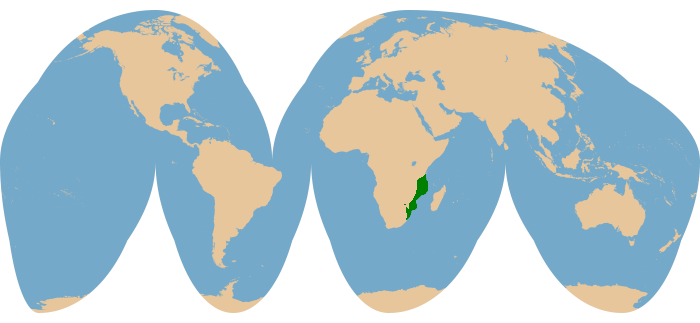Kingdom: |
Animalia Chordata Mammalia Artiodactyla Ruminantia Bovidae Cephalophinae Cephalophus |
Common name:
Scientific name:
Other names: |
Red duiker
Cephalophus natalensis
Natal red duiker, Céphalophe du Natal, Céphalophe rouge, Rotducker, Mkumbi, Chisimbi |
Physical Characteristics
- Head and body length:
70-80 cm
- Shoulder height: 38-48 cm
- Tail length: 8-11 cm
- Adult weight: 9.2-13.6 kg
- Shoulder height: 38-48 cm
The red duiker is relatively small and slender; females tend to be larger and heavier than males. Both sexes are a uniform tawny red, with individuals from the northern part of the species' range being brighter and more rufous. The underparts are typically only slightly paler than the rest of the body. Distinctively, the back of the neck is grayish brown and there is no dorsal stripe. The tail is narrow and has a white tip. The face is slightly darker than the body, the chin is white, and the small ears are bordered with black. A prominent crest of longer hair on the forehead is typically chestnut brown. Both sexes have stout spike-like horn; those of females are short (2-4.5 cm) and may be hidden within the forehead crest. Horns of males are typically 4.5-8.0 cm (up to 10.1 cm) long and have heavily-ringed bases.
- Similar species
- The red duiker is the only red-colored duiker in its range; it is larger and more rufous than the sympatric blue duiker (Philantomba monticola) and suni (Neotragus moschatus).
- Harvey's duiker (Cephalophus harveyi) is sometimes considered a subspecies of red duiker, but can be distinguished by its darker legs and black facial blaze.
- Aders's duiker (Cephalophus adersi) shares similar overall coloration, but has a distinctive white stripe across the rump and thighs, and characteristic white freckles on the lower legs.
Reproduction and Development
- Gestation period: 216 days.
- Litter size: One.
- Weaning: Unknown.
- Sexual maturity: Unknown.
- Life span: Up to 15 years.
- Litter size: One.
The red duiker is a non-seasonal breeder, with births occuring year-round. Infants are approximately one kilogram at birth, and are very dark - almost black - in color. For at the least their first two weeks, neonates lie hidden in dense thickets and are visited periodically by their mothers for nursing.
Ecology and Behavior
This duiker is almost exclusively diurnal, with notable peaks of activity just after dawn and before dusk. However, a substantial portion (24-69%) of the daylight hours may be spent resting in dense cover. Red duikers do not appear to be territorial, and the home ranges of multiple individuals may overlap. There are few lasting social associations and in areas of overlap these duikers tend not to use the same areas at the same time. Home range size is usually between 2 and 15 hectares. Red duikers typically forage in areas with an open understory, but if startled they rush for cover almost immediately. Although "duiker" means diver (they usualy dive headfirst into dense vegetation), this species is an excellent jumper and can clear obstacles over 1.6 m high. On numerous occasions, red duikers have been observed associating with vervet monkeys - not just foraging on food dropped by the monkeys, but also allowing the primates to groom them.
- Family group:
Typically solitary.
- Diet: Primarily fallen leaves, as well as fruits, seeds, and flowers when available.
- Main Predators: Numerous medium- and large-sized predators, including leopard.
- Diet: Primarily fallen leaves, as well as fruits, seeds, and flowers when available.
Habitat and Distribution

Conservation Status
- IUCN Red List:
Least Concern (2016).
- CITES Listing: Not listed (2017).
- Threats: Habitat loss, hunting.
- CITES Listing: Not listed (2017).
No recent population estimates have been made, and a 1999 estimate of 42,000 individuals is likely an underestimate. This duiker has disappeared from large parts of its historic range as a result of agricultural conversion of land. It is still relatively common in a number of protected areas.






